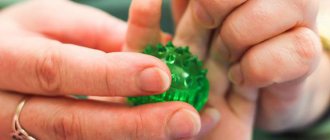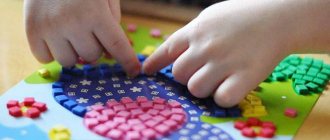Fine motor skills are one of the most important skills for any person. It needs to be developed equally carefully not only for children, but also for adults. Many people neglect the simplest training, not realizing how necessary it is. It is with our hands that we hold cutlery to eat, write, draw, grab desired objects and perform many other actions.
Have you thought about it? Then we suggest mastering the following exercises for fine motor skills in adults. They will help maintain mobility and health at any age.
What are fine motor skills?
Fine motor skills are the ability to coordinate the movements of the small muscles of the wrist, palms, fingers, and even toes. General motor skills are the ability to coordinate the movements of large muscles of the arms, legs and feet, as well as the ability to control the entire body. How to develop hand motor skills in a child? To do this, you can perform special exercises with him and play age-appropriate games. Even the simplest exercises, such as moving a toy brick or picking up a piece of food from a plate, prepare your baby for more complex tasks, such as writing or buttoning up buttons. It must be remembered that a child’s development can proceed in different ways, and everyone develops at their own pace. Compared to other children, your baby's development of fine and gross motor skills may be either advanced or delayed, and this is normal.
Exercises using additional objects
In addition to the fact that exercises using additional objects are very exciting and entertaining, they excellently contribute to the development of spatial imagination.
Among these games are:
- Mosaic. To begin with, it is enough that the baby simply inserts mosaic elements into the base. Subsequently, you should specify a specific image or shape for the child to post it. The ideal option would be a mosaic with different hats.
- Abacus. Give your child the task of moving the counting rings from one end to the other. To develop counting skills, you can also move the rings in order.
- Threads. This refers to the usual winding and unwinding of threads on various objects. You can, for example, select figures of some animals in advance, and the child will wrap them with threads, giving them color. These same figures can be used for games.
- Paper clips. To play this game, you will need regular colored paper clips and several sheets of colored paper. The task is to collect leaves of the same color into a small bundle, and then fasten them with the same paper clip.
- Bolts and nuts. Nothing fancy is required - just large bolts and nuts. And the point of the game is even simpler - screw the nuts onto the bolts.
- Clothespins. Take clothespins and attach them to rope, cardboard or any other base. The task can also be complicated: some identification marks are glued onto the base and clothespins, for example, colored cards or letters, and the child attaches the clothespins to the corresponding bases.
In fact, this list of games for developing fine motor skills is not exhaustive. For this purpose, you can find some other games or come up with your own. Remember that anything is suitable for developing motor skills: water, sand, laces, wire, paper, etc. and so on.
And one more thing: developing fine motor skills is useful not only for children, but also for adults, so even if you don’t have children, go to the store for plasticine, and we assure you, the evening will be usefully spent.
We also recommend reading:
- Storytelling
- A selection of courses for children and parents
- How to teach a child to read: rules, tips and tricks
- Speech thinking in children and adults: what is it and why is it needed?
- A person's main limiting belief
- Top 5 most important soft skills for every child
- BRAIN digest
- Exercises for memory development in preschoolers
- Factors in a child’s intellectual development
- Piaget's theory of cognitive development
- Dyslexia: Definition, Causes, Symptoms and Treatment
Key words:1Children
Fine motor skills in children from 1 to 3 months
At the age of up to 1 month, in accordance with the norms of child development, the baby’s hands are usually clenched into fists, and the fingers clasp the thumb. If you put a rattle in his hand, he can grab it, and that's all for now. If you run your finger across your baby's palm, he will grab it tightly. However, you should not try to lift it - the child may suddenly let go of the finger. This is just one of many infant reflexes that a child has from birth - the palmar grasp reflex, and the baby has no control over it. At about 3 months of age, the baby's arms begin to relax. The palm is in a half-open position most of the time. Now, if you put a rattle in his hand, he can grab it, bring it to his mouth, or drop it when he stops being interested.
How to develop hand motor skills in a child from 1 to 3 months
During this period, the following actions are recommended for the development of the child:
- Shake a toy in front of him or over his head. The child will reach for it or pat it with his hand.
- Give your child bright objects, if possible in different sizes, shapes and textures.
Summarize
| At this stage, the child develops the following elements of hand motor skills: ● He can squeeze and unclench his palm. ● He brings his hands to his mouth. ● He can hold a toy like a rattle and shake it. |
Fine motor skills in children from 4 to 7 months
At 4 months, in accordance with the norms of child development, the baby usually holds the rattle tightly, can shake it, put it in his mouth and even transfer it from hand to hand. At the age of 4 to 7 months, the child uses his palms as claws or a rake, that is, he lifts objects of interest to him with a raking motion. The baby can also grab an object with one hand, transfer it to the other, and make a rotational movement of the wrist towards himself in order to examine the thing.
How to develop hand motor skills in a child from 4 to 7 months
What can be done for the development of a child at this age:
- Place toys at some distance from the baby so that he has an incentive to reach for them.
- Let him play with blocks and stuffed animals to develop his hand-eye coordination.
Summarize
| So, a baby between the ages of 4 and 7 months usually develops the following elements of hand motor skills: ● He can reach for objects with one hand. ● He transfers objects from one hand to another. ● He can lift objects using a raking motion with his palm. |
Pain in the hand and working at the computer: what is the connection?
Today, almost everyone has a laptop or desktop computer. Even older people confidently surf the Internet or otherwise spend time in front of a screen. Scientists have come to the conclusion that some hand diseases arise as a result of prolonged monotonous movements of the hands on the keyboard. We are talking about neuromuscular disorders or chronic diseases of the hands, which are accompanied by muscle cramps.
Working with the keyboard is reminiscent of playing the piano and requires prolonged tension of the fingers. Over time, sensitivity at the peripheral nerve endings decreases, cramps occur in the hands, and coordination of finger movements is lost. It is not surprising that complaints about the hands not obeying are more often heard from people who deal with computers.
Scientists have expressed the opinion that the design of a modern keyboard needs to be improved. The key mounting should be modified to reduce vibration as much as possible. It is this that becomes a resonator of strong excitation of nerve endings and leads to inhibition of nerve centers and a decrease in the sensitivity threshold. If this issue can be resolved, long-term work at the computer will become less dangerous for the joints of the hand!
Fine motor skills in children from 8 to 12 months
From 8 months to 1 year, the child’s general motor skills rapidly develop: as a rule, he can already crawl, stand up independently, and sometimes even walk. But hand motor skills are not far behind, you just need to take a closer look. At this stage, in accordance with the norms of child development, the baby switches from a raking movement to clamping an object between the thumb and index or middle finger. This way he is able to lift even small objects the size of a corn ring or a breakfast ball. You can even show him how to snap his fingers, and sometimes the child is even able to repeat it! Don't be surprised if your baby starts throwing things at this age. He'll be so excited about his new, improved hand coordination that he'll enjoy picking up objects and throwing them, hoping you'll pick them up and give them to him. With these actions, the child learns to understand the relationship between cause and effect, and also tries to attract your attention. If he starts throwing toys, encourage him to play with soft balls rather than wooden blocks. At this stage, it is best to remove all fragile objects from your baby, otherwise he may throw a salt shaker or your phone on the floor. For his and your safety, we recommend temporarily switching to plastic utensils. By the way, as part of measures to ensure the safety of your child’s home, remove fragile decorative elements, such as vases, away.
How to develop hand motor skills in a child from 8 to 12 months
For the development of a child at this age, it is useful to play joint games aimed at coordinating hands and fingers. Here are some examples:
- Sit on the floor next to your baby and take a large ball (and if the ball rings or rattles, it will be even more interesting for the baby). Roll the ball towards the child. Let him roll it towards you too. At first, the baby will simply clap the ball, but over time he will learn to roll it purposefully.
- Give your baby something that opens and closes, such as a box with a lid. You can hide your baby’s favorite toy in the box and say “peek-a-boo” when he lifts the lid.
- Give your child a basket with different items: soft toys, balls, safe household items like wooden spoons and cups. Let the baby take them one at a time from the basket and put them back. At this time, you can tell your child the name of each object, what its shape, texture and color are.
- At this age, children love latches, wheels, levers, hinges - in general, anything that can move. Try to choose toys for him with these properties.
Summarize
| A child aged 8 to 12 months develops the following elements of hand and finger motor skills: ● He can grasp objects by holding them between the thumb and forefinger, shake them, hit them, transfer them from hand to hand, release them arbitrarily or throw them. ● He can knock objects together to make sounds (like wooden blocks). ● He can build towers from cubes and break them. ● He puts toys and other items in the container and takes them back out. ● He can stick his index finger into the holes. ● He holds the crayon or pencil in his fist and moves it across the surface. |
What other diseases can cause hand failure?
There are a lot of joint diseases, and only an experienced doctor will determine whether you have arthrosis or arthritis, or maybe gout or a simple injury.
- Rheumatoid arthritis . Due to an autoimmune failure, the body perceives its own cells as foreign and destroys the joint. The disease develops in both hands. Over time, fingers become deformed, curved and lose mobility. Pathological changes begin early - at the age of 25-30, but upon reaching an older age a person has a pronounced set of symptoms.
- Gout . Uric acid crystals accumulate in the joints, causing severe pain. The disease begins in the lower extremities and gradually moves to the upper extremities. Gouty bumps due to the deposition of salts in the joints are especially painful at night and calm down in the morning.
- Arthritis . Infectious joint inflammations are common. Acute arthritis is accompanied by severe pain and swelling, and fever. Chronic – reminds itself after prolonged stress on the joints.
This is what an inflamed hand with arthritis looks like
Fine motor skills in children aged 1 year
Congratulations! Your baby is one year old! At this age, the child’s development is progressing by leaps and bounds, and he can already do a lot of things. Parents are usually impressed by gross motor skills, particularly the long-awaited first steps, but there is also something to be surprised about in the area of fine motor skills. Thanks to improved gross motor skills, the child is increasingly eager to explore the world around him. In the process, fine motor skills are also improved. The baby still cannot grasp the smallest objects, but this achievement is not far off. While your child enjoys exploring and playing with larger objects, such as wooden blocks and wooden puzzles. At this stage, significant progress occurs in the development of hand-eye coordination. Nowadays, the child increasingly uses one hand, but this does not mean that his leading hand has already been determined (that is, he will be left-handed or right-handed).
How to develop hand motor skills in a child aged 1 year
As your child gets older, you can do the following exercises to develop hand motor skills:
- Show your child how to fold paper. You can make an accordion fan or a paper airplane with it.
- Have your child insert different shaped blocks or pegs (square, rectangular, triangular) into the corresponding holes.
- Show him how to stack the blocks on top of each other to make a tower.
- Offer him toys that can be taken apart and put together safely, such as a set of cups that nest inside each other.
- Invite him to sculpt something from plasticine.
- Entrust him with simple housework, such as sweeping, arranging items, or helping you prepare food (stirring pancake batter or putting vegetables in a pan).
- Play together outside, for example, you can throw a ball to each other.
Summarize
| Between the ages of 1 and 2 years, a child develops the following skills and abilities: ● He can build a tower from blocks and immediately break it. ● He plays with boxes, containers and their lids. ● He can lift a moving object, such as a ball. ● He leafs through books. ● He turns the door handles. ● It knows how to insert pins into the corresponding holes. ● He draws with pencils or fingers. ● He knows how to drink from a mug. ● He can feed himself with a spoon (with varying degrees of success). |
Why do they refuse to work?
The hands are a complex mechanism that can withstand enormous loads. However, under unfavorable conditions, as well as with age, they lose functionality. Movement is difficult and causes pain, which impairs the quality of life. The causes of arthralgia are divided into two groups: inflammatory and mechanical. It is very easy to determine inflammation: the skin turns red and swells, persistent pain appears, and the range of motion is reduced.
If the symptoms are not so obvious, but discomfort occurs periodically, the cause may be arthrosis of the hand. The disease develops against the background of metabolic disorders. The cartilage in the joints loses its elasticity, microcracks and invisible defects appear in them, which intensify over time.
In all joints, large and small, identical processes occur:
- the formation of synovial fluid, which acts as a natural lubricant in the joint, is disrupted;
- the edges of the damaged cartilage become denser;
- Bone growths form around the joint, limiting mobility, and pain occurs.
With arthrosis, the hand looks as usual, there are no signs of inflammation
Fine motor skills in children aged 2 years
Sometimes this period in children's development is called the “two-year crisis.” And although it can be difficult for parents of two-year-olds, try to focus on the good - that your baby continues to grow and develop.
Fine motor skills of the hands and fingers continue to improve. The baby is now able to pick up small objects the size of a pea and perform actions that require complex coordination, such as opening a jar.
How to develop hand motor skills in a child aged 2 years
During this period, the child develops the ability to focus attention. Now he can immerse himself in creative endeavors for a short time. Here are some of the things you can get involved in:
- Read books out loud to your child and let him turn the pages.
- Invite him to draw with crayons, colored pencils or fingers using special paints.
- Play with blocks or construction toys with him.
Summarize
| Between the ages of 2 and 3 years, a child develops the following skills: ● He can leaf through the pages of a book or magazine. ● He builds towers with at least six bricks. ● He knows how to take off his shoes. ● He knows how to unbutton a jacket. ● When potty training, he can take off and put on panties on his own. ● He can turn doorknobs. ● It opens and closes jars with screw caps. ● He knows how to drink from a mug, holding it with one hand. ● He knows how to unwrap candy. ● He holds the pencil in the correct position and can make strokes in different directions. |
Fine motor skills in children aged 3 years
At this stage of development, children already control their muscles much better. For example, at this age a child can move his fingers both individually and all together. This is noticeable in the way he holds a pencil or crayon - now it looks more like how an adult would do it. At this age, the child begins to pay more attention to what surrounds him, in particular objects. For example, during play he arranges toys in a special way. He can use various tools and devices similar to adults, for example, he cuts out shapes from paper with children's scissors. He is getting better at making things from scrap materials. Some children at this stage enjoy experimenting with art materials.
How to develop hand motor skills in a child aged 3 years
Here are some examples of useful and interesting activities that contribute to a child’s development:
- Make buildings from cubes.
- Solve simple puzzles together.
- Play with a board with holes.
- Make a necklace from thread and large beads.
- Color in coloring books with crayons or draw on the pavement with chalk.
- Build sand castles.
- Dress dolls in doll clothes with buttons, zippers and fasteners.
Your child can be assigned simple and safe tasks around the house (with supervision, of course):
- Help adults build a dollhouse, unscrew something with a screwdriver or hammer a nail with a light hammer.
- Help plant flowers in the garden, dig a hole with a shovel, loosen the soil with a rake.
- Beat eggs for omelettes or batter for pancakes with a whisk.
Summarize
| Around the age of 3 to 4 years, a child masters the following skills: ● He can hold a crayon or pencil in his hand like an adult (between the thumb and all the rest). ● Sometimes he manages to hold cutlery in his hand like an adult (between the thumb and all the rest). ● He eats on his own and rarely spills anything on the table or on himself. ● He builds a tower of at least nine cubes in height using cubes. ● He knows how to pour drinks from a jug into his mug. ● He independently buttons and unfastens the buttons on his clothes. ● He uses baby scissors to cut out geometric shapes from paper. ● He sculpts various figures from plasticine. |
Fine motor skills in children aged 4 years
A child at 4 years old is already quite big, and the development of hand motor skills is almost complete.
How to develop hand motor skills in a child aged 4 years
Around this time, the child begins to be interested in artistic creativity, complex games and other activities that require manual dexterity. For example, he may be interested in the following activities:
- Draw full-length human figures with arms, legs and face.
- Write block and capital letters.
- Draw, trace and sketch geometric shapes.
- Draw with paint and fingers.
- Sculpt figures from plasticine.
- Cut out complex shapes from paper using children's scissors.
- Play with blocks and use them to build tall or massive structures, such as a tower or fortress.
- Play cards or board games.
Summarize
| At the age of 4 years, a child usually develops the following skills: ● He knows how to brush his teeth independently under the guidance of his mother. ● He dresses independently with virtually no help from his mother. ● He knows how to tie his shoelaces. ● He has no problem using cutlery, even a knife. ● He goes to the toilet on his own and takes care of himself. |







